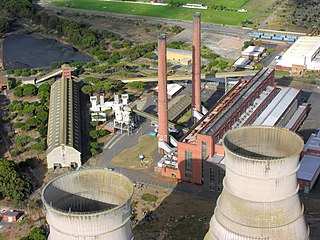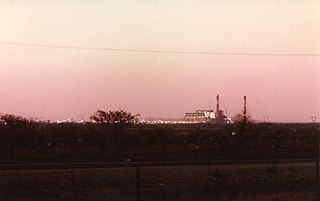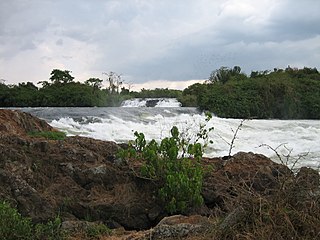Related Research Articles

A power station, also referred to as a power plant and sometimes generating station or generating plant, is an industrial facility for the generation of electric power. Power stations are generally connected to an electrical grid.

The Ludington Pumped Storage Plant is a hydroelectric plant and reservoir in Ludington, Michigan. It was built between 1969 and 1973 at a cost of $315 million and is owned jointly by Consumers Energy and DTE Energy and operated by Consumers Energy. At the time of its construction, it was the largest pumped storage hydroelectric facility in the world.

Duke Energy Corporation is an American electric power and natural gas holding company headquartered in Charlotte, North Carolina.

Morupule Thermal Power Station is a coal-fired power station in Botswana. It is responsible for an estimated 80 percent of the country's domestic power generation.

Many countries and territories have installed significant solar power capacity into their electrical grids to supplement or provide an alternative to conventional energy sources. Solar power plants use one of two technologies:

Iran has the Third largest oil reserves and the 2nd largest natural gas reserves in the world. The nation is a member of OPEC, and generates approximately 50% of state revenue through oil exports.

The Nellis Solar Power Plant is a 14-megawatt (MW) photovoltaic power station located within Nellis Air Force Base in Clark County, Nevada, northeast of Las Vegas. The power plant was inaugurated in a ceremony on December 17, 2007, with Nevada Governor Jim Gibbons activating its full operation. On average, it has since generated 32 gigawatt-hours of electricity annually and supplied more than 25% of the power used at the base.

Burning of renewable resources provides approximately 90 percent of the energy in Uganda, though the government is attempting to become energy self-sufficient. While much of the hydroelectric potential of the country is untapped, the government decision to expedite the creation of domestic petroleum capacity coupled with the discovery of large petroleum reserves holds the promise of a significant change in Uganda's status as an energy-importing country.

The Solana Generating Station is a solar power plant near Gila Bend, Arizona, about 70 miles (110 km) southwest of Phoenix. It was completed in 2013. When commissioned, it was the largest parabolic trough plant in the world, and the first U.S. solar plant with molten salt thermal energy storage. Built by the Spanish company Abengoa Solar, the project can produce up to 280 megawatts (MW) gross, supplied by two 140 MW gross (125 MW net) steam turbine generators: enough electricity to meet the needs of approximately 70,000 homes and obviate the emission of roughly 475,000 tons of CO2 every year. Its name is the Spanish term for "sunny spot".

As of April 2020, the energy sector in Senegal has an installed capacity of 1431 megawatts (MW). Energy is produced by private operators and sold to the Senelec energy corporation. According to a 2020 report by the International Energy Agency, Senegal had nearly 70% of the country connected to the national grid. Current government strategies for electrification include investments in off-grid solar and connection to the grid.

The Bujagali Power Station is a hydroelectric power station across the Victoria Nile that harnesses the energy of its namesake; the Bujagali Falls, in Uganda. Construction began in 2007 and concluded in 2012. It was officially inaugurated on 8 October 2012 by Ugandan President Yoweri Museveni and Aga Khan IV in the presence of African politicians and investors.
The Ruacana Hydroelectric Power Station is a hydroelectric power plant near Ruacana in northwest Namibia, close to the Angolan border. Commissioned in 1978, it is by far the largest power station in Namibia. Its operator is NamPower, the Namibian national electric power utility company.

The Catawba Nuclear Station is a nuclear power plant located on a 391-acre (158 ha) peninsula, called "Concord Peninsula", that reaches out into Lake Wylie, in York, South Carolina, US. Catawba utilizes a pair of Westinghouse four-loop pressurized water reactors.
Energy in Sudan describes energy and electricity production, consumption and imports in Sudan. The chief sources of energy in 2010 were wood and charcoal, hydroelectric power, and oil. Sudan is a net energy exporter. Primary energy use in Sudan was 179 TWh and 4 TWh per million persons in 2008.
Taiba N'Diaye Wind Power Station,, is a 158.7 MW (212,800 hp) wind power plant in Senegal. The power station is the largest wind power station in West Africa, by generation capacity.
The Corbetti Geothermal Power Station, is a 500 MW (670,000 hp) geothermal power station, under construction in Ethiopia. When fully developed, the power station will be the largest grid-ready independently developed geothermal power station in the country. The developers of this power plant plan to expand it from 10 megawatts to 60 megawatts, then to 500 megawatts and to possibly 1,000 MW. They have given themselves until 2030 to complete this renewable energy development.
Mozambique has abundant energy sources available for exploitation. As of 2021, the country was ranked first in energy potential of all the countries in the Southern African Power Pool (SAPP), with an estimated energy capacity of 187,000 MW. Available energy sources include coal, hydroelectricity, natural gas, solar energy and wind power. As of September 2021, the largest proportion of the power currently generated is from hydroelectric sources. However the energy mix in the country is changing. Natural gas powered energy stations are expected to provide 44 percent of total energy generation from 2020 to 2030.
References
- ↑ Overview of Electrical Power In Senegal
- ↑ Built In 2006, Expanded To 102 Megawatts In 2011 Archived 2011-12-30 at the Wayback Machine
- ↑ Capacity At Tambacounda Is 6 Megawatts
- ↑ Bel Air Power Station Constructed In 2005, Upgraded To 102MW In 2011 Archived 2011-12-30 at the Wayback Machine
- ↑ Nellie Peyton (24 February 2020). "Senegal opens West Africa's first big wind farm in push for renewables". London: Thomson Reuters Foundation . Retrieved 26 September 2020.